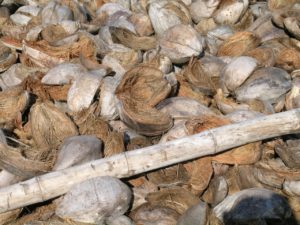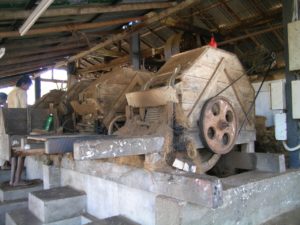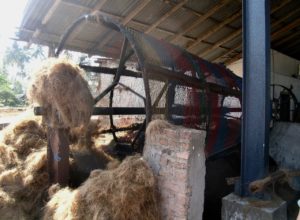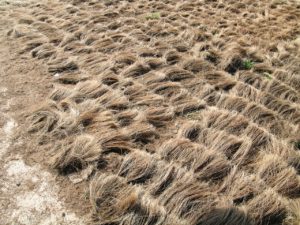An extremely hardwearing and very strong fibre derived from the husk of the coconut, the fruit of the coconut palm, Cocos nucifera.
Images takes from a small coir / coconut fibre operation in the countryside.
Each palm tree produces a continuous, yearly crop of 50-100 fruits. Their shells are crushed to extract the coir, which is the fibrous outer part of the husk–leaving the hard inner shell for other uses, such as buttons. Coir fibres are hollow with thick cellulose walls that need to be extracted and processed as with any bast fibre.
A little on the coarse side of luxury, coir is the perfect hardwearing ‘soft’ flooring. It can be woven and tufted like carpet, creating its own self-backing. Deep pile coir is used for door mats; set into mat wells at the entrances of many commercial buildings, you can see it in the foyers of most banks, in the entrances of most high street shops and in country houses, where it picks up the mud and other detritus brought underfoot or on the pushchair wheels.
Coir comes in a wide tonal range from almost off white through warm gold to light brown.
Brown coir: is harvested from fully ripened coconuts.
The husks are soaked in pits of slow moving water to swell and soften the fibres (called retting). The longer coarse outer, bristle fibres are separated from the shorter matress fibres beneath by wet milling. The shorter mattress fibres are cleaned, dried in the sun and packed up into bales.
A percentage of the mattress fibre is allowed to retain more moisture so that it remains elastic for fibre production. The long bristle hair is washed and tied into bundles, which are cleaned and hackled with steel combs to remove impurities, the weaker and shorter fibres.
Brown coir is thick, strong, and with a high abrasion resistance making it suitable for brushes, twine and sacking, and heavy duty, thick, brush-like mats. The shorter mattress hairs are used for upholstery as horsehair substitute. Bundles are stitched together–in mats–a traditional upholstery technique–needle felting to make thick mats ( or thin mattresses ) which among other things are used for insulation, packaging and on banks and hillsides to stem soil erosion. Brown coir will not take a dye.
Other uses: as garden and horticultural fertiliser, soil improver and as a pest deterrent–snails hate it.
White Coir: is taken from the under-ripe coconut–being less mature, the lighter, fine fibres are weaker but softer to the touch, and so are used for ropes and to weave widths for flooring and rugs.
As with brown coir, these immature husks are first retted–in this case, the nuts are suspended in a river or water-filled pit for up to ten months, after which the husks are broken into segments, the long fibres removed, dried and cleaned. The fibres are spun into yarn that is woven into cloth and flooring. It’s woven in plain, basket, herringbone and bouclé weave with a jute or similar weft.
This process is being revised, as the retting is damaging to water inhabitants. Instead a new, non-polluting system is being developed by NIIS–India’s National Institute for Interdisciplinary Science and Technology in Thiruvananthapuram.
White coir can be bleached and takes dye reasonably well, so you see it in many colours, usually green-ey greys and browns.
Performance and use:
Setting: as with any other natural flooring, coir is strong and can be used in any area and location: for seaside, island and rural homes. Its natural colour demands nothing, gives warmth and depth. It is often confused with sisal as it looks very similar.
Wall to wall: coir needs a competent and experienced fitter who really understands the material. It’s not carpet but can be laid in the same way. I always specify a wool or cotton and felt underlay with gripper rod, then a loose binding or bronze nailing to finish the edges. Coir beds itself into the felt, staying in position and making a soft, warm and sound deadening walk. Coir is also fine on stairs, although again only if well fitted.
Joins: the usual width restrictions mean that at some stage joins are inevitable; these should always run along the length and the two pieces hand stitched together in situ. For thresholds use wood – light oak or linen covered bars–never cheap metal. Or ask your fitter to lay it without threshold joints.
Edges: linen bindings always look good with woven floorings–perhaps around the whole room but always to edge hearths, stairs, mat wells and on landings around the banisters. These must be hand stitched in situ to look good; using a 5cm (c.a. 2”) binding with approx 1-1.5 cm (c.a. 0.4-0.6”) on top and the rest folded under. Neutral or toning colours will blend in, contrast adds interest.
We’ve use contrast bindings around the perimeters of many rooms and either sides of stair carpets to create a runner effect. Either use a narrow edging of 1-1.5 cm, which looks especially good with uneven cottagey walls, or emphasise the shape with a full 5-6 cm. A strong formal edging looks really good if the walls are straight and the architecture strict.
Stairs: coir is fine on stairs as long as it is securely fitted, as with all stair coverings, to prevent any slippage. We’ve fitted stair runs for many years in heavy use homes and business premises and have never had any problems, other than a little premature wear on the bottom step after 5-6 years– something that can easily be replaced.
If you have concerns, stop the coir at the top and bottom and fit a flat weave wool stair runner between, stripes or a sympathetic geometric pattern offer good contrast.
Rugs: any size and shape of rug can be achieved by cutting down larger pieces or hand stitching seams. Linen bindings look good in toning or contrasting tones, as do leather, felt, flat wool embroideries, tapestries, anything goes so long as it is always hand stitched. The cost is well worth it.
Durability: it is extremely hardwearing and will last for many years.
Maintenance: it really does look after itself. The jute wefts are the weaker elements, and these can be re-stitched if they show signs of wear.
Cleaning: vacuum regularly to remove surface dust. Like all natural materials such as stone, slate and wood, coir needs time to ‘walk up’ to age; to start with all marks and spots will show, but as the material ages the surface changes and stains become either absorbed into or repelled by the mature material.
Bathrooms: coir will stain dark brown around the edges if it has to hold water, so it is not recommended for bathrooms
Under floor heating: coir is perfect laid over concrete and underfloor heating. Lie onto padded paper or thick cotton felted underlay, which keeps it soft underfoot.
Practicality: coir is the harshest of the natural, soft floor coverings, so it needs a rug. I’ve used seagrass and other rush mattings in my own dining rooms and children’s rooms–most dropped food, including sultanas and soft fruit and sticky play materials will come out with a stiff brush. This is with relatively careful use–I wouldn’t use it in a kitchen.
Similar products : agave, abaca, jute, sisal, seagrass, rush…




